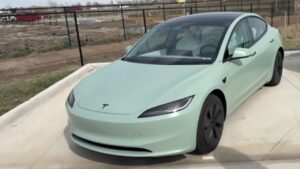On July 31, 2025, space enthusiasts worldwide turned their eyes to NASA’s Kennedy Space Center in Florida as SpaceX successfully launched the Crew-11 mission, marking the 11th crew rotation flight to the International Space Station (ISS) under NASA’s Commercial Crew Program. This historic rocket launch, powered by a SpaceX Falcon 9 and Crew Dragon spacecraft, carried four astronauts to the ISS for a long-duration mission. In this blog post, we’ll dive into the details of the SpaceX Crew-11 launch, its significance, and what makes this event a milestone in space exploration.

Credit by nasa.gov
The SpaceX Crew-11 Mission: Overview
The Crew-11 mission launched at 12:09 p.m. EDT (1609 GMT) from Launch Complex 39A at Kennedy Space Center, Florida. The mission is a collaboration between NASA, SpaceX, JAXA (Japan Aerospace Exploration Agency), and Roscosmos, showcasing international cooperation in space exploration. The crew consists of four astronauts:
-
NASA Astronaut Zena Cardman (Commander): Making her first trip to space, Cardman leads the mission with her expertise and training.
-
NASA Astronaut Mike Fincke (Pilot): A veteran astronaut on his fourth ISS mission, bringing extensive experience to the team.
-
JAXA Astronaut Kimiya Yui (Mission Specialist): On his second ISS visit, Yui represents Japan’s contributions to the mission.
-
Roscosmos Cosmonaut Oleg Platonov (Mission Specialist): A first-time space traveler, Platonov joins as part of Russia’s commitment to the ISS program.
These astronauts will spend approximately six months aboard the ISS, conducting scientific experiments, performing maintenance, and advancing research in microgravity.
The Launch: A Spectacle at Kennedy Space Center
The SpaceX Falcon 9 rocket, topped with the Crew Dragon spacecraft, lifted off under favorable weather conditions, lighting up the Florida sky. The launch was a testament to SpaceX’s reusable rocket technology, with the Falcon 9’s first-stage booster successfully landing at Landing Zone-1 at Cape Canaveral Space Force Station shortly after liftoff. This booster return marks another step in SpaceX’s goal to reduce the cost of spaceflight through reusability.
Spectators gathered at prime viewing spots along Florida’s Space Coast, including locations recommended by NASA and the Space Coast Launches app, to witness the rocket’s ascent. The launch was also streamed live by NASA and SpaceX, allowing millions worldwide to watch the event in real-time. For those who missed it, replays are available on NASA’s website and SpaceX’s X account.
Why Crew-11 Matters
The Crew-11 mission is more than just another trip to the ISS—it’s a critical milestone in NASA’s Commercial Crew Program and SpaceX’s ongoing partnership with the agency. Here are some key reasons why this launch is significant:
-
New Propulsion System: The Crew Dragon spacecraft for Crew-11 features a new propulsion system in its trunk, designed to boost the ISS’s orbit. This is a crucial development for SpaceX’s ISS Deorbit Vehicle, which will guide the station to a controlled reentry around 2030–2031 when its operational life ends.
-
International Collaboration: The diverse crew highlights the global effort to maintain the ISS as a hub for scientific research. NASA, JAXA, and Roscosmos continue to work together despite geopolitical challenges, emphasizing the unifying power of space exploration.
-
Zena Cardman’s First Flight: Originally assigned to Crew-9 but reassigned to make room for other astronauts, Cardman’s leadership as commander on her first space mission is a landmark achievement for NASA’s astronaut corps.
-
SpaceX’s Record-Breaking Year: The Crew-11 launch is part of SpaceX’s ambitious 2025 schedule, aiming for a record-breaking 170 orbital launches. This mission underscores SpaceX’s reliability as NASA’s partner for crewed and cargo missions.
What’s Next for Crew-11?
After reaching the ISS, the Crew-11 astronauts will join the existing Expedition 74 crew, including Roscosmos cosmonauts and NASA astronauts already aboard. Their mission includes:
-
Conducting over 200 scientific experiments in areas like biology, physics, and materials science.
-
Performing spacewalks to maintain and upgrade the ISS.
-
Preparing the station for future commercial space activities as NASA transitions to private space stations by the 2030s.
The crew is expected to return to Earth in early 2026, splashing down off the coast of Florida aboard their Crew Dragon spacecraft.
Other Launches on July 31, 2025
The Crew-11 mission wasn’t the only space event on July 31. SpaceX also launched a batch of 19 Starlink satellites into low-Earth orbit from SLC-4E at Vandenberg Space Force Base, California, at 12:25 p.m. EDT (1625 GMT). This launch, part of SpaceX’s Starlink mega-constellation, further expands global internet coverage. The rapid succession of launches highlights SpaceX’s operational tempo and its dominance in the commercial space sector.
How to Stay Updated on Space Launches
If you’re a space enthusiast eager to follow more rocket launches, here are some tips:
-
Download the Space Coast Launches App: This app provides real-time updates, live streams, and viewing locations for launches from Kennedy Space Center and Cape Canaveral.
-
Check SpaceX and NASA Websites: Both organizations offer live streams and detailed mission updates. SpaceX’s X account also posts launch highlights.
-
Visit Kennedy Space Center Visitor Complex: For an immersive experience, explore the complex or take a bus tour to see launch pads up close.
-
Follow Space Launch Schedule Websites: Sites like SpaceLaunchSchedule.com and NextSpaceflight.com offer comprehensive launch calendars.
Conclusion
The SpaceX Crew-11 launch on July 31, 2025, from NASA’s Kennedy Space Center was a triumph of engineering, international collaboration, and human ambition. Carrying four astronauts to the ISS, this mission reinforces SpaceX’s pivotal role in space exploration and NASA’s commitment to advancing science in orbit. From the reusable Falcon 9 booster landing to the innovative propulsion system on Crew Dragon, the launch showcased cutting-edge technology that will shape the future of spaceflight.
Whether you watched the launch live or are catching up now, the Crew-11 mission is a reminder of humanity’s relentless pursuit of the stars. Stay tuned for more updates on the crew’s journey and SpaceX’s upcoming launches as 2025 continues to be a record-breaking year for space exploration. For the latest news, visit NASA.gov, SpaceX.com, or download the Space Coast Launches app to never miss a rocket launch again.


